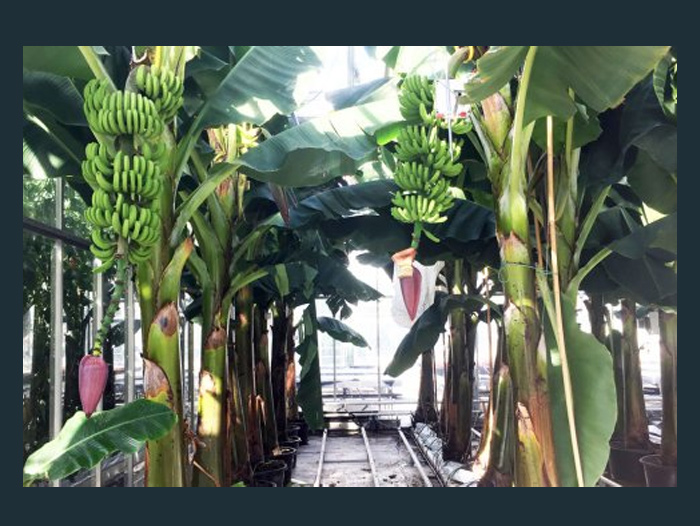Sustainable Bananas in Greenhouses: First ‘Dutch Bananas’ Harvested
December 21, 2018 | 2 min to read

Researchers from Wageningen University & Research are harvesting the first Dutch bananas this week. Boerenhart, a supplier of fresh and local products will offer the bananas as ‘regional product’ to restaurants and hospitals in the region of Wageningen. The cultivation took place on two types of substrates: coco peat and rock wool. This allows the growth of banana without the settlement of aggressive fungi.
In the greenhouses of the experimental farm Unifarm in Wageningen a unique research experiment has been carried out since January. Bananas grow in the greenhouse in pots and on a substrate, both artificial media for plant growth. “For the 100th anniversary of WUR, we developed this plan together with the local cooperation Boerenhart: the cultivation of a regional banana in the Wageningen greenhouses,” says Professor of Tropical Plant Pathology Gert Kema. “With this experiment we will investigate whether this cultivation offers prospects for further research into mastering Fusarium wilt. This is due to a soil borne fungal pathogen that threatens the banana production throughout the world. So we took the banana out of the soil.”
Bananas grow excellent on stone wool
The experiment appears to be very successful, says Prof. Kema. “The banana plants grow very well on coco peat and stone wool substrate with only the application of a nutrient solution. The advantage of substrate cultivation is that nutrients can be better tailored to the needs of the plant. In addition, you prevent losses, possibly about 30%, from leakage. The Dutch banana does not need disease control, which makes cultivation more sustainable than in traditional production areas.”
– Unfortunately, your cookie settings do not allow videos to be displayed. – check your settings
Sixty banana plants
There are sixty plants in the greenhouse, but there are hundreds of thousands of hectares of banana production worldwide. “One of the things that we have learned is that the plant density is too high at the moment. We are going to adjust that, so that we will have more light and the bunches will be able to ripen faster in future experiments”, says Prof. Kema.
Some partners within the Dutch banana project – Wageningen University & Research, Boerenhart, Triple20, Keygene and Chiquita – are interested in continuing this method of cultivation in greenhouses or other buildings in order to serve a small regional market. “Think of consumers or restaurants and hospitals in the region. This way we can also start growing other varieties, for a more diverse range. We are also planning a trial in the Philippines to see how precision cultivation works under ideal conditions.”
Sustainable banana cultivation worldwide
The bananas in the Wageningen greenhouses are now ready to be harvested. Then they go to a ripening centre of Chiquita. “We are on the way to developing sustainable banana cultivation with new breeds of bananas that are resistant to diseases and that are grown in healthy soils in a responsible social climate,” says Kema.
